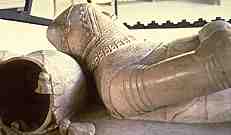





If you are looking at this page without frames, there is more information about medieval writing to be found by going to the home page (framed) or the site map (no frames).
| Miniatures (2) | |||||
| With works of a more secular nature, miniatures illustrate the text of the current page, serving in the nature of chapter headings or marking significant passages. These images are not depicted realistically, especially in terms of scale and perspective. Generally the more important components of the picture are relatively bigger. There is much in these illustrations that depicts medieval life. It may be a sanitised and deodorised version of medieval life as seen from the perspective of the aristocracy or wealthy middle classes, but it gives us an image of how medieval people wished to depict themselves and their world. | |||||
 |
 |
||||
| On the left, Conwy Castle in Wales as depicted in a 15th century manuscript miniature (British Library, Harley MS 1319, f.14b), from an old postcard. On the right, Conwy Castle as it stands today. | |||||
 |
 |
||||
| On the left, a detail of armed soldiers from a miniature in the same manuscript as above (f.44), from an old postcard. Above, the funerary effigy of an early 15th century knight in the church of West Tanfield, Yorkshire. | |||||
 |
In a detail from a miniature in a 14th century edition of the Life of St Denis (Paris, Bibliothèque Nationale, MS Fr.2090-2092, Vol.II, f.111) the various citizens of Paris are depicted going about their daily business in a fairytale castle version of the city. (From New Palaeographical Society 1906) | ||||
| Many scenes from everyday life are depicted in the miniatures of Die Miniaturen der Manesseschen Liederhandschrift, an early 14th century songbook. | |||||
| The examples of such contemporary depictions are innumerable and have been much pillaged for schoolbooks on what the middle ages were like. It has to be something of an art to pick out the authentic details from the artistic conventions. It is hard to imagine the grim grey walls of Conwy Castle ever looking like a pink icing romantic castle, but the manuscript image does allow us to imagine the ruined interior of the castle with large and magnificent buildings. The design of the armour of the soldiers is authentic, according to contemporary funerary sculpture, but one is inclined to doubt that companies of footsoldiers clanked around in full plate armour. The diversity of Paris life is represented by stereotypes, arranged on a stage set, with no beggars, lepers, dung in the streets or animal carcases in the river. | |||||
| There is much to be learned about medieval life from manuscript miniatures, but they were not produced for the purpose of educating us. They reflected back to their contemporary owners a flattering and romantic image of the world they lived in. This self flattery even went so far as to include the patron or owner of the work depicted in a pious or important role in a miniature. Sir Geoffrey Luttrell sits in caparisoned splendour on his horse, while the Duc de Berry has the temerity to flash his jewelled insignia to St Peter at the gates of heaven. The function of these images was display; display of significance, display of wealth and, at least as the end of life approached, display of piety. | |||||
| Miniature of Sir Geoffrey Luttrell with his horse, wife daughter and coat of arms, from the Luttrell Psalter, f.202v, now in the British Library. Photograph from Joan Evans 1949 English Art 1307-1461 Oxford: Clarendon Press. (Click on image for a larger view.) | |||||
| The Duc de Berry, and his castles, feature heavily in the Tres Riches Heures, which can be seen in detail at the Christus Rex site. | |||||
 |
Three donor figures adorn the lower panel of a stained glass window in the church of All Saints, North Street, York. | ||||
| The pious display of self, as found in the donor figures in many late medieval stained glass windows, is similar in conception to the personal imagery in medieval religious manuscripts. | |||||
|
|
|||||
|
|
|||||
|
If you are looking at this page without frames, there is more information about medieval writing to be found by going to the home page (framed) or the site map (no frames). |
|||||